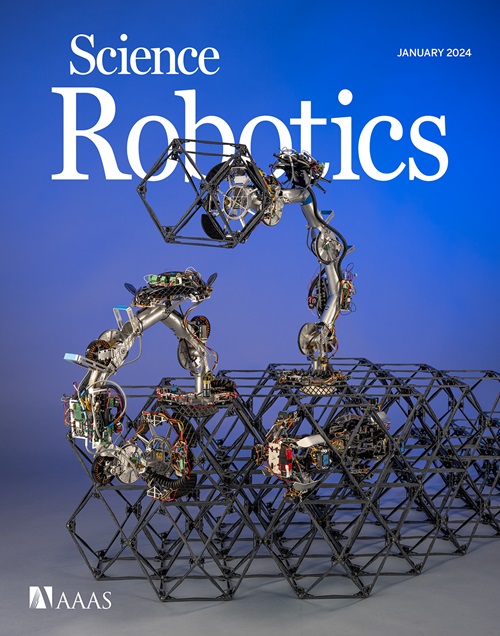磁性微型机器人在肝动脉中的人体级导航
IF 26.1
1区 计算机科学
Q1 ROBOTICS
引用次数: 0
摘要
利用外部驱动源导航血液中的无系药物洗脱微机器人在提高给药选择性方面大有可为,尤其是在肿瘤学领域,但目前的场力很难在人体内(直径70厘米范围内)保持足够的强度来实现这一操作。在此,我们提出了一种算法,用于预测血管内微型机器人导航过程中病人相对于重力的最佳位置。利用临床磁共振成像(MRI)中的磁场梯度进行的磁共振导航与该算法相结合,提高了磁性微型机器人(MMR)的瞄准效率。利用专用微粒子注射器、高精度核磁共振成像兼容球囊充气系统和临床核磁共振成像,成功地引导磁微机器人通过活猪的肝动脉进入靶叶。微机器人(每头猪大约有 2000 个 MMR)在右肝叶的分布率从 47.7% 增加到 86.4%,在左肝叶的分布率从 52.2% 增加到 84.1%。在通过多个血管分叉后,与对照组相比,导航组到达四个不同目标肝叶的MMR数量增加了1.7至2.6倍。对19名肝细胞癌(HCC)患者进行的模拟实验表明,所提出的技术可以满足HCC患者的肝栓塞需求。我们的技术为基于致动器的微型机器人导航提供了可选择的方向,达到了人体尺度。本文章由计算机程序翻译,如有差异,请以英文原文为准。
Human-scale navigation of magnetic microrobots in hepatic arteries
Using external actuation sources to navigate untethered drug-eluting microrobots in the bloodstream offers great promise in improving the selectivity of drug delivery, especially in oncology, but the current field forces are difficult to maintain with enough strength inside the human body (>70-centimeter-diameter range) to achieve this operation. Here, we present an algorithm to predict the optimal patient position with respect to gravity during endovascular microrobot navigation. Magnetic resonance navigation, using magnetic field gradients in clinical magnetic resonance imaging (MRI), is combined with the algorithm to improve the targeting efficiency of magnetic microrobots (MMRs). Using a dedicated microparticle injector, a high-precision MRI-compatible balloon inflation system, and a clinical MRI, MMRs were successfully steered into targeted lobes via the hepatic arteries of living pigs. The distribution ratio of the microrobots (roughly 2000 MMRs per pig) in the right liver lobe increased from 47.7 to 86.4% and increased in the left lobe from 52.2 to 84.1%. After passing through multiple vascular bifurcations, the number of MMRs reaching four different target liver lobes had a 1.7- to 2.6-fold increase in the navigation groups compared with the control group. Performing simulations on 19 patients with hepatocellular carcinoma (HCC) demonstrated that the proposed technique can meet the need for hepatic embolization in patients with HCC. Our technology offers selectable direction for actuator-based navigation of microrobots at the human scale.
求助全文
通过发布文献求助,成功后即可免费获取论文全文。
去求助
来源期刊

Science Robotics
Mathematics-Control and Optimization
CiteScore
30.60
自引率
2.80%
发文量
83
期刊介绍:
Science Robotics publishes original, peer-reviewed, science- or engineering-based research articles that advance the field of robotics. The journal also features editor-commissioned Reviews. An international team of academic editors holds Science Robotics articles to the same high-quality standard that is the hallmark of the Science family of journals.
Sub-topics include: actuators, advanced materials, artificial Intelligence, autonomous vehicles, bio-inspired design, exoskeletons, fabrication, field robotics, human-robot interaction, humanoids, industrial robotics, kinematics, machine learning, material science, medical technology, motion planning and control, micro- and nano-robotics, multi-robot control, sensors, service robotics, social and ethical issues, soft robotics, and space, planetary and undersea exploration.
 求助内容:
求助内容: 应助结果提醒方式:
应助结果提醒方式:


